Assailants Of Iran International Presenter Were Eastern European Mercs - Report

British investigators believe that the three suspects sought in connection with the stabbing of Iran International's presenter are from Eastern Europe.

British investigators believe that the three suspects sought in connection with the stabbing of Iran International's presenter are from Eastern Europe.
According to an exclusive report by the Guardian on Thursday, the investigators are looking into whether one of the suspects has connections to Albania.
The investigators interviewed by The Guardian believe that the assailants were recruited and flown to the UK specifically to execute the assault.
Iran International presenter Pouria Zeraati was stabbed outside his home in Wimbledon, in south London, late in March and sustained leg injuries.
Shortly after the attack, London Metropolitan Police announced that considering previous threats against journalists in Persian-language media outlets, the incident is being handled by specialized officers from the Met's counter-terrorism division. Earlier in the month, London Metropolitan police said the three suspects fled the UK after the attack, triggering an international manhunt.
Guardian further reported that Western sources believe that those likely responsible for the attack, presumed to be acting in the interests of the Iranian regime, utilized connections and insights into criminal networks to recruit the assailants.
Senior British counter-terrorism officials, as per The Guardian's report, believe that employing "criminal proxies provides Tehran with plausible deniability" as those recruited are unlikely to be on terror watchlists which would prevent them from entering the UK.
Last year, federal indictments revealed that three individuals linked to an Eastern European mafia group were charged by the United States for plotting to assassinate Iranian-American journalist and activist Masih Alinejad at the request of the Iranian regime.
The US Justice Department announced that the Eastern European mafia group charged "has ties to Iran and is violent, engaging in murders, kidnappings, assaults, and extortions".

A senior IRGC commander warned Thursday that Tehran could change its nuclear policies if Israel continues to threaten to attack Iran’s nuclear sites, tacitly suggesting no cooperation with world bodies and building a nuclear bomb.
“If the fake Zionist regime wants to use the threat of attacking nuclear sites to put pressure on Iran, it is possible and conceivable for the Islamic Republic to revise its nuclear doctrine and policies, and deviate from its past declared considerations,” said Ahmad Haghtalab, who is in charge of the security of Iran’s nuclear sites.
His remarks came a day after Zohar Palti, the former intelligence director at the Israeli spy agency Mossad, announced that Israel has many options on the table to retaliate Tehran’s recent missile and drone attacks and could even choose to strike Iran’s nuclear facilities.
According to Haghtalab, Israel’s threats to target Iran’s nuclear facilities “are not from today or yesterday” and Israel has already been involved in “sabotage and terrorist acts” to stop Iran’s nuclear program over the past years.

One of the most significant attacks on Iran’s nuclear program occurred in 2010 when the Stuxnet computer virus disrupted the control systems of the country’s most sensitive and tightly watched nuclear facility in Natanz.
The Dutch daily Volkskrant reported in January that the malware, widely believed to be an American-Israeli creation, was delivered by a Dutch engineer working at the enrichment plant.
In 2020 and 2021, two internal explosions hit Iran's highly protected Natanz uranium enrichment facility, inflicting considerable damage. The attacks were attributed to Israel, although Iran's chief adversary never took responsibility. In November 2020, Mohsen Fakhrizadeh, known as the father of Iran's nuclear program was assassinated in broad daylight near Tehran.
Further in his remarks, IRGC Commander Haghtalab threatened that the Iranian government can target Israel’s nuclear sites if the Jewish state decides to respond to Iran’s recent offensive on the Israeli territory: “The nuclear sites of the Zionist enemy have been identified and we have the information we need on all targets. In case of their so-called retaliation, our hands are on the trigger to fire powerful missiles to destroy specified targets.”
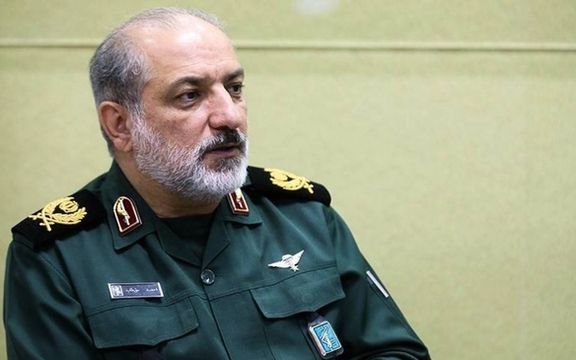
On Saturday night, Iran launched its first ever direct offensive against Israeli territory with more than 350 drones and cruise and ballistic missiles. The Israeli army announced that 99% of the projectiles were intercepted and downed.
According to IAEA Director General Rafael Grossi, Iran shut down its nuclear facilities last Sunday over “security considerations.” He confirmed that the facilities had reopened within 24 hours, but with no IAEA supervision, as the agency decided to temporarily keep its inspectors away until the situation is “completely calm.”
When asked about the possibility of Israel hitting Iran’s nuclear sites, Grossi said, “We are always concerned about this possibility.” The UN nuclear chief also reiterated the IAEA’s concerns about Iran’s nuclear program.
Iranian officials have always maintained that Tehran’s nuclear program is purely for peaceful purposes. But nuclear experts are almost unanimous in their assessment that enrichment to the levels and in the amounts that Iran has been doing since 2021 cannot be justified in the absence of a weapons program.
In February, Ali-Akbar Salehi, the former head of Iran's nuclear agency, implied that the country has everything it needs for an A-bomb: "We have [crossed] all the thresholds of nuclear science and technology. Here's an example: Imagine what a car needs; it needs a chassis, an engine, a steering wheel, a gearbox. You're asking if we've made the gearbox, I say yes. Have we made the engine? Yes, but each one serves its own purpose."
On Wednesday, an advisor to Iranian Parliament Speaker Mohammad-Bagher Ghalibaf hinted at Tehran’s military use of its nuclear program. “Iran has a nuclear program in addition to its missile program,” wrote Mehdi Mohammadi on X in what can be construed as a shrouded threat against Israel and its allies.
Meanwhile, Mohammad Marandi, a political analyst close to Iran’s hardliners, claimed that Iran has not yet used “its most advanced weapons” against Israel. When asked if Iran might use nuclear weapons, he said, “Iran is not like the United States which has and uses and has already used nuclear weapons.”
In November, an IAEA confidential report indicated that Iran has enough uranium enriched to up to 60% for three atomic bombs.
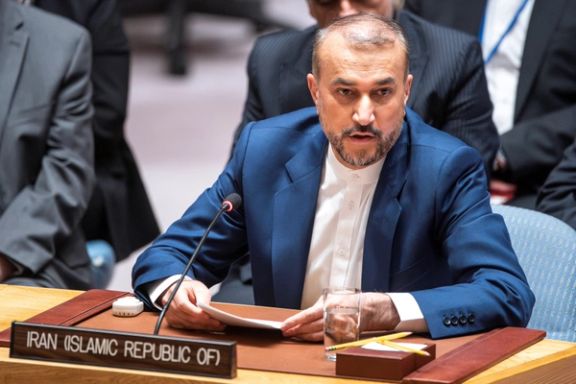
Iran told the United Nations Security Council on Thursday that Israel "must be compelled to stop any further military adventurism against our interests" as the UN secretary-general warned that the Middle East was in a "moment of maximum peril."
Israel has said it will retaliate against Iran's April 13 missile and drone attack, which Tehran says was carried out in response to an Israeli strike on its consulate in Damascus earlier this month.
"In case of any use of force by the Israeli regime and violating our sovereignty, the Islamic Republic of Iran will not hesitate a bit to assert its inherent rights to give a decisive and proper response to it to make the regime regret its actions," said Iran's Foreign Minister Hossein Amir-Abdollahian.
His remarks came after an Iranian Revolutionary Guards commander said earlier on Thursday that Iran could review its "nuclear doctrine" following Israeli threats.
At a UN Security Council meeting on the Middle East, Secretary-General Antonio Guterres urged maximum restraint.
"It is high time to end the bloody cycle of retaliation. It is high time to stop," Guterres said. "The international community must work together to prevent any actions that could push the entire Middle East over the edge, with a devastating impact on civilians."
Speaking earlier on Thursday in the Security Council, Israel's UN Ambassador Gilad Erdan criticized Amir-Abdollahian's presence at the world body.
"He is here to make a mockery of you. He is here to show you all – in your suits and with your diplomatic niceties – that his country can launch an attack on another member state on Saturday, and then he can come here on Thursday to lecture you all on human rights and international law," Erdan said.
(Report by Reuters)
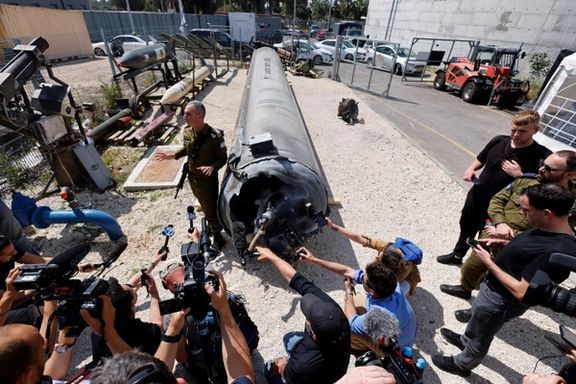
The Israeli army on Tuesday pulled out an 11-meter (36-foot) long remnant of one of the Iranian ballistic missiles that had crashed into the Dead Sea following the large-scale Sunday attack and showed it to reporters.
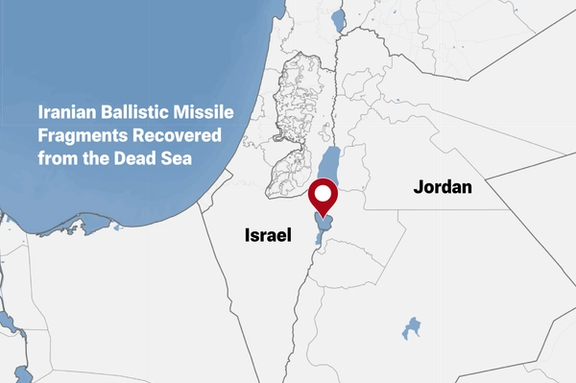
The Islamic Republic has remained silent on the type of missiles used in the early Sunday morning attack, leaving the details shrouded in secrecy. However, by analyzing Israeli military reports and combining them with open-source intelligence, analysts suggest that one of the missiles might have been an Emad (Imad) missile. The Israel Defense Forces (IDF) spokesperson confirmed that only the fuel tank of the intercepted missile was recovered, as the warhead and engine were destroyed by the long-range Arrow air defense system.

According to the Israeli army, the recovered debris represents 70% of the original projectile's length. Analysis of released photographs and statements aligns with the specifications of Iran's Emad missile. The Emad, according to Iranian Revolutionary Guard-affiliated media, is a 15.5-meter ballistic missile. Ballistic missiles follow a curved trajectory, leveraging gravity to achieve extreme velocities. The Israel Defense Forces (IDF) estimate the missile traveled over 1,500 kilometers from Iran to Israel in roughly 12 minutes, reaching a speed of approximately 7,500 km/h, or roughly Mach 6.
Named after Imad Mughniyeh, the second-in-command of Hezbollah who was killed in 2008, the missile is manufactured by the Iranian defence ministry and underwent its first test launch in 2015. Just a few months ago, the IRGC conducted a simulated military operation, demolishing the mock Palmachim Airbase in Israel using Emad missiles.
Which missiles did Iran deploy in its assault on Israel?
IRGC-affiliated media have revealed details about the variety of missiles used in the attack on Israel. This included ballistic missiles such as the Khorramshahr, Sejjil, Ghadr, and Emad, alongside cruise missiles like the Paveh and the hypersonic Fattah. However, inconsistencies arose within official Iranian channels. For example, one newspaper suggested that Iran held back from deploying the Fattah hypersonic missiles, potentially reserving more advanced weapons for a future counter-attack. Amir Ali Hajizadeh, the commander of the IRGC Aerospace Forces, claimed on Thursday that the IRGC used its older models in the attack.
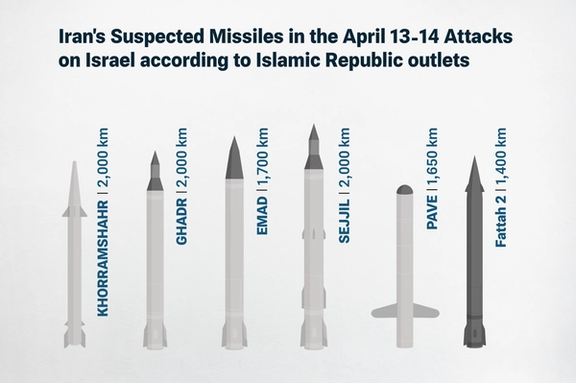
Setting the Scene: Exploring the Context
The Islamic Republic of Iran currently boasts the most extensive and varied ballistic missile arsenal in the Middle East. Iran's pursuit of ballistic missiles predates the Islamic revolution in 1979. However, it was during the Iran-Iraq War, fueled by animosity towards the West and their refusal to supply spare parts for Iran's dwindling air force after the monarchy's fall, that Tehran significantly ramped up its missile program.

Chronicles of Iran's Missile Campaign
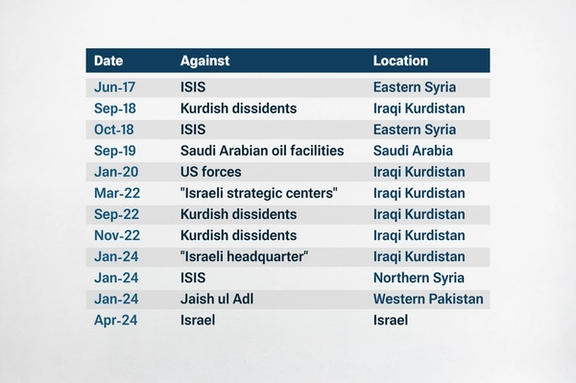
Since 2017, Iran has launched missiles towards other countries on at least twelve occasions. These attacks involved over 300 ballistic and cruise missiles primarily targeting regional Muslim-majority nations. Iraq, bordering Iran, bore the brunt of these attacks, while Israel received the highest number of missiles.

Many strikes were launched in retaliation for perceived provocations against Iran, but the targeted nations often remained silent. This silence likely stemmed from a lack of military capability or willingness to respond, as seen in Iraq and Syria. Notably, Pakistan stood out for its swift and decisive response to an Iranian missile attack.

What Comes Next?
In its attack on Israel, Iran launched more than 300 killer drones, cruise missiles, and ballistic missiles on Israeli territory. Only four ballistic missiles successfully made it through the defences, with none of the cruise missiles or drones managing to do so, said Israel defence minister Yoav Gallant.
Now with the region in the brink of war, Israel stands at a crossroads. It faces the choice between a military strike on Iranian soil or diplomatic patience for future benefit. The absence of an attack may likely result in a false sense of victory for the Islamic Republic, while a military strike on Iranian soil could potentially drag the region into full-scale conflict. Meanwhile, the Islamic Republic stands on edge, bracing for Israel's next move.
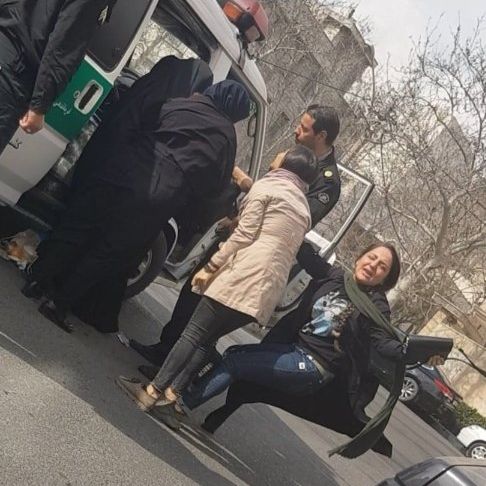
Multiple women arrested by the morality police in the latest crackdown since the weekend have informed Iran International about severe violence including severe physical assault as well as sexual verbal abuse.
A 17-year-old girl said that when she was arrested in Tehran’s Daneshjoo Park, the officers treated her violently, pulling her hair and beating her right arm and thighs with a baton, in addition to making sexual insults.
Male officers in the morality police van that transported the arrested women to a detention center beat the women who refused to submit to arrest.
The young woman told Iran International that at the detention center, the officers made women unlock their mobile phones and to reveal their picture galleries and social media accounts to the brutal state security. She saw more than fifty women in custody, most of whom were in their early 20s or teens.
A 19-year-old girl told Iran International that she refused to unlock her phone for the plainclothes officers at the detention center, so they hit her stomach and genitals with an electric shocker, addressed her with sexual profanity and sexually insulted her family. She was forced to cooperate to avoid being taken to the security agencies.
Several hours after their arrest, both of these girls were released from the detention center after providing their details, home addresses, telephone numbers, and fingerprints and signatures on sheets that were written "did not respect the hijab."
Reports given to Iran International indicate that hundreds of women have been arrested throughout the country, including Tehran and Karaj, for disobeying the mandatory hijab since Saturday when a new policy called project Noor, came into place, allowing further oppression for women and girls amid nationwide hijab refusal.
An Iranian journalist and post-graduate student of political science, Dina Ghalibaf, 24, was arrested at her home in Tehran on Tuesday after describing in a tweet her recent encounter with the police.
On Monday, she sent out a series of tweets in which she described how police used a shocker and handcuffed her at the Sadeghieh metro station for not wearing the mandatory veil.
Shahed Alavi, an editor of the Iran International Newsdesk, states that the regime is concerned people may expand their power and overthrow the government should the country be vulnerable to an attack by Israel amid the two countries' shadow war which came to the fore on Saturday night when Iran launched a massive aerial bombardment towards the Jewish state.
“This is not the Iranian people’s war. The state does not have the nation on its side, yet the regime is trying to force legitimacy by instilling fear and inflicting violence,” he added.
“The government wishes to demonstrate that while they are weak in foreign policy, they still possess power in the domestic arena,” Alavi said.

Aida Shakarami, the older sister of the slain 16-year-old Iranian protester Nika Shakarmi, was arrested in Tehran yesterday by the Islamic Republic's guidance patrol for not wearing the hijab.
"Yesterday, my daughter Aida was arrested by Tehran's moral security police for not wearing the mandatory hijab and is still in custody," the siblings’ mother Nasrin Shakarami wrote in an Instagram post.
Iranian authorities have recently escalated their violent crackdown on women for defying the country’s mandatory Islamic hijab laws, with reports of mass arrests across the country.
Some human rights activists argue that the regime is using the crisis and ‘state of war’ with Israel to suppress dissent – and that the country’s Supreme Leader, Ali Khamenei, enacted controversial measures during this time to avoid public backlash.
Nika was kidnapped and murdered by state security forces during unprecedented nationwide protests in Iran in September 2022, following the killing of 22-year-old Mahsa Jina Amini in custody of the so-called “morality police” in Tehran.
Just four days after Amini was killed, videos showed Nika setting fire to her hijab at a protest in Tehran. When Nika suddenly went missing, authorities refused to give the family any answers. After 10 days, authorities informed the family that Nika’s body had been found.
The authorities claimed that Nika had committed suicide. The teenager’s family has repeatedly denied these claims and stated that she was killed as a result of repeated blows to her head.
Subsequent reports indicated that Nika was raped by state security forces before they killed her. Since her murder, the Shakarami family has persistently been targeted with threats from authorities, and several members of the family were detained.
Last October, Aida Shakarami revealed that unidentified individuals had threatened her family while they visited Nika’s grave – telling them that Nasrin, the siblings’ mother, would face arrest.
Nika’s story and death at the hands of the regime turned her into one of the beloved icons of the movement for many Iranians.
Last year, Amnesty International reported that Iranian authorities are “waging a ruthless campaign of harassment and intimidation against the families of protesters and bystanders unlawfully killed by security forces during the “Woman Life Freedom” uprising to force them into staying silent…”.






